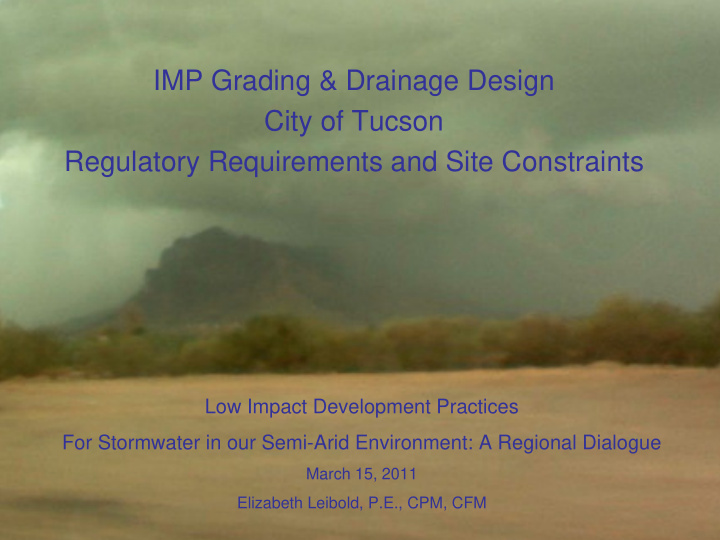



IMP Grading & Drainage Design City of Tucson Regulatory Requirements and Site Constraints Low Impact Development Practices For Stormwater in our Semi-Arid Environment: A Regional Dialogue March 15, 2011 Elizabeth Leibold, P.E., CPM, CFM
• Design for LID success • Don’t overlook a design constraint that could delay the project, in review, or at post-construction inspections. • Integrate parameters to save $ & time
Some Design Constraints to Consider Some Design Constraints to Consider Drainage � Retention � Mosquitoes � Drain-down time � Maintenance � Rainwater Harvesting regulations Grading � Geotechnical recommendations � SFR’s and other special projects � Grading Standards � Utilities
Drainage � Retention � Mosquitoes � Drain-down Time � Integrate landscaping requirements with engineering requirements. � Minimize ponding issues that can cause stagnant water, mosquitoes, or other health concerns. � Prevent water infiltration affecting adjacent buildings, retaining walls, or pavement. � City of Tucson requires 12 or 24 hours* for drain-down time of retention systems. � Soils within Water Harvesting Infiltration Areas should be modified as needed to counteract the effects of mechanical compaction and/or poor soil infiltration conditions in order to ensure appropriate water infiltration. DS Sec.10-03.3.1.A.4 � Soils report is required for surface storage facilities which utilize infiltration for basin drainage. * Depending on upstream watershed area. See DS Sec.10-01.3.5.1.3
Drainage For drainage facilities for private development, maintenance reports � Maintenance are required annually. See DS Sections 10-02.14.6 and 10-03.7.2 DS Sec.10-03.6.1 : All Passive and Active Water Harvesting System components, Water Harvesting Infiltration Areas, and other site improvements necessary for the water harvesting system to function properly, should be regularly inspected and maintained. The following maintenance requirements should be addressed on the Implementation Plan. A. All systems . Periodically inspect and clean gutters, leaf screens, and filters. Inspect systems following heavy rains to check for leaks and/or overflow problems. Periodically inspect and maintain Water Harvesting Infiltration Areas to ensure proper infiltration, overflow, and prevention of erosion, if occurring. Repair and correct problems. B. Passive Systems . In addition to requirements for all systems, to ensure proper functioning of Passive Water Harvesting Systems, periodically inspect and maintain subwatershed surfaces and infrastructure associated with the system such as French drains, spillways, scuppers and other elements. Repair and correct problems as needed. C. Active Systems . In addition to requirements for all systems, to ensure proper functioning of Active Water Harvesting Systems periodically inspect tanks, access hatches and associated locks, overflow devices, pipes, pipe joints and connectors, pumps, vents, controllers, and other associated infrastructure. Empty first flush devices as needed after rainfalls to ensure correct operation in the next rainfall. Inspect systems following heavy rains to check for leaks and/or overflow problems. Determine whether sludge should be removed from tanks. Repair and correct problems as needed. D. Irrigation systems . Irrigation systems and associated controllers, soil moisture sensors, tensiometers, weather stations, and any other associated instruments shall be properly maintained and replaced as needed to ensure the potable and reclaimed water-saving goal of the Ordinance is met.
Drainage � Rainwater Harvesting City of Tucson adopted new Water Harvesting Regulations effective June 2010. (Ordinance No. 10597, the Commercial Rainwater Harvesting Ordinance) Compare total amount of water available (estimated rainfall) in a given month to that month's total landscape requirements. If there is a surplus that can be used in a reasonable amount of time, consider a storage system. A minimum of 50% of the landscape water budget shall be supplied by harvested rainwater. City of Tucson Rainwater Harvesting Guidance Manual and CD-ROM available on-line to download at: http://www.ci.tucson.az.us/water/harvesting.htm or http://www.dot.ci.tucson.az.us/stormwater/education/waterharvest.cfm
Grading � Geotechnical recommendations – setbacks For more requirements, check: 2006 IBC code - Section 1803.3 (10-ft at 5%) Development Standards (DS Section 11-01.9, DS Section 10- 03.3.1.A.5) COT / Detention Retention Manual ( DS Section 10-01 ) Land Use Code / Tucson Code
When elongated-shaped landscape borders are used for retention, assure positive gradient to minimize ponding beyond the maximum drain down time. Source: City of Tucson Water Harvesting Seminar 2010
Grading � SFR’s and other special projects Space is limited – feasibility of sufficient grading setbacks and slope run out is critical to making Waterharvesting for limited lot area or high density SFR’s can provide projects work. opportunities for saving on your water bill. New City of Tucson regulations for Gray Water requirements: Gray Water Ordinance: http://cms3.tucsonaz.gov/files/agdocs/20080923/sept23-08-527a.pdf Gray Water Brochure: http://cms3.tucsonaz.gov/sites/default/files/dsd/brochure%20final%200910_1.pdf Gray Water Guide: http://cms3.tucsonaz.gov/sites/default/files/dsd/Booklet%20final%200910_1.pdf
Grading Design paving to direct water to � Grading Standards plants in landscape borders or other retention systems. Where long sections of the landscape border occur, a Type 1 scupper may be proposed to cross sidewalk areas. Source: City of Tucson Water Harvesting Seminar 2010
Grading � Utilities First part of any project design is locating existing utilities. Utility trenches are to be avoided when locating water harvesting / retention structures. Avoid having infiltration of water into existing bedding materials of trenches, which could cause voids beneath the pipes that can create potential for pipe weakening, cracks, and leakage. Source: Low-Impact Development Design Strategies - An Integrated Design Approach, Department of Environmental Resources, Prince George’s County, Maryland
Design for LID success Design for LID success Drainage � Retention � Mosquitoes � Drain-down time � Maintenance � Rainwater Harvesting regulations Grading � Geotechnical recommendations � SFR’s and other special projects � Grading Standards � Utilities
Questions? Contact: Summary: City of Tucson PDSD 1 st Floor When designing stormwater catchments, 201 N Stone Av consider integrating techniques, options, Elizabeth Leibold, P.E., CPM, CFM and requirements: Email Address: G eotechnical Elizabeth.Leibold@tucsonaz.gov Phone: 837-4934 L andscaping A rchitectural D rainage You’ll be glad you did! Sources: City of Tucson Development Standards: Commercial Water Harvesting, Grading Standards, Stormwater Detention/Retention Manual, City of Tucson Drainage Manual Low-Impact Development Design Strategies - An Integrated Design Approach, Department of Environmental Resources, Prince George’s County, Maryland 2006 IBC Code
Recommend
More recommend